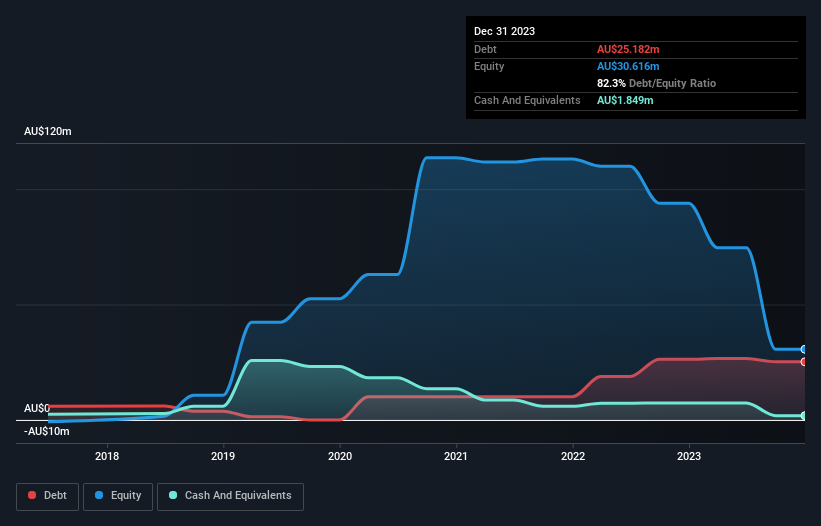
The external fund manager backed by Berkshire Hathaway's Charlie Munger, Li Lu, makes no bones about it when he says 'The biggest investment risk is not the volatility of prices, but whether you will suffer a permanent loss of capital.' When we think about how risky a company is, we always like to look at its use of debt, since debt overload can lead to ruin. As with many other companies Ecofibre Limited (ASX:EOF) makes use of debt. But should shareholders be worried about its use of debt?
What Risk Does Debt Bring?
Debt is a tool to help businesses grow, but if a business is incapable of paying off its lenders, then it exists at their mercy. Part and parcel of capitalism is the process of 'creative destruction' where failed businesses are mercilessly liquidated by their bankers. While that is not too common, we often do see indebted companies permanently diluting shareholders because lenders force them to raise capital at a distressed price. Of course, debt can be an important tool in businesses, particularly capital heavy businesses. The first thing to do when considering how much debt a business uses is to look at its cash and debt together.
See our latest analysis for Ecofibre
What Is Ecofibre's Debt?
The image below, which you can click on for greater detail, shows that Ecofibre had debt of AU$25.2m at the end of December 2023, a reduction from AU$26.2m over a year. However, because it has a cash reserve of AU$1.85m, its net debt is less, at about AU$23.3m.

A Look At Ecofibre's Liabilities
We can see from the most recent balance sheet that Ecofibre had liabilities of AU$21.6m falling due within a year, and liabilities of AU$21.0m due beyond that. Offsetting this, it had AU$1.85m in cash and AU$2.45m in receivables that were due within 12 months. So it has liabilities totalling AU$38.3m more than its cash and near-term receivables, combined.
When you consider that this deficiency exceeds the company's AU$25.6m market capitalization, you might well be inclined to review the balance sheet intently. In the scenario where the company had to clean up its balance sheet quickly, it seems likely shareholders would suffer extensive dilution. There's no doubt that we learn most about debt from the balance sheet. But it is Ecofibre's earnings that will influence how the balance sheet holds up in the future. So when considering debt, it's definitely worth looking at the earnings trend. Click here for an interactive snapshot.
Over 12 months, Ecofibre made a loss at the EBIT level, and saw its revenue drop to AU$30m, which is a fall of 2.1%. We would much prefer see growth.
Caveat Emptor
Importantly, Ecofibre had an earnings before interest and tax (EBIT) loss over the last year. Its EBIT loss was a whopping AU$20m. When we look at that alongside the significant liabilities, we're not particularly confident about the company. We'd want to see some strong near-term improvements before getting too interested in the stock. Not least because it had negative free cash flow of AU$12m over the last twelve months. So suffice it to say we consider the stock to be risky. There's no doubt that we learn most about debt from the balance sheet. But ultimately, every company can contain risks that exist outside of the balance sheet. We've identified 4 warning signs with Ecofibre (at least 2 which shouldn't be ignored) , and understanding them should be part of your investment process.
When all is said and done, sometimes its easier to focus on companies that don't even need debt. Readers can access a list of growth stocks with zero net debt 100% free, right now.
Valuation is complex, but we're helping make it simple.
Find out whether Ecofibre is potentially over or undervalued by checking out our comprehensive analysis, which includes fair value estimates, risks and warnings, dividends, insider transactions and financial health.
View the Free AnalysisHave feedback on this article? Concerned about the content? Get in touch with us directly. Alternatively, email editorial-team (at) simplywallst.com.
This article by Simply Wall St is general in nature. We provide commentary based on historical data and analyst forecasts only using an unbiased methodology and our articles are not intended to be financial advice. It does not constitute a recommendation to buy or sell any stock, and does not take account of your objectives, or your financial situation. We aim to bring you long-term focused analysis driven by fundamental data. Note that our analysis may not factor in the latest price-sensitive company announcements or qualitative material. Simply Wall St has no position in any stocks mentioned.

Simply Wall St
About ASX:EOF
Ecofibre
Ecofibre Limited, together with its subsidiaries, engages in the researching, producing, and selling of polymer-based industrial products and hemp derived nutraceuticals and food in the United States and Australia.
Slightly overvalued with imperfect balance sheet.
